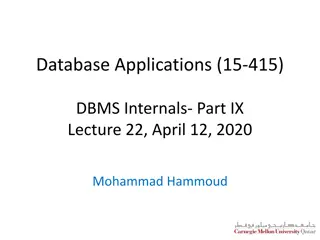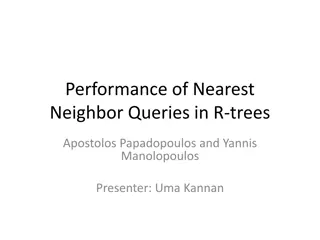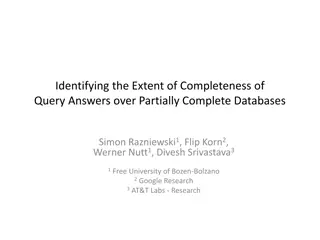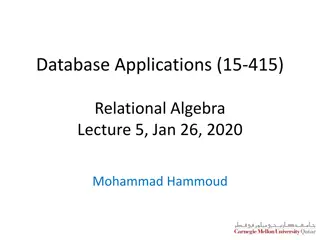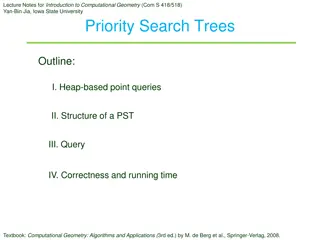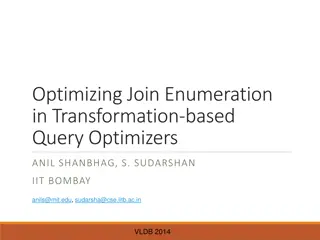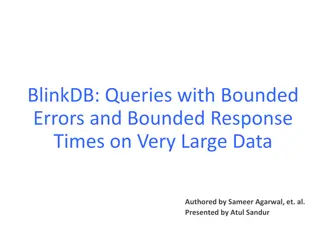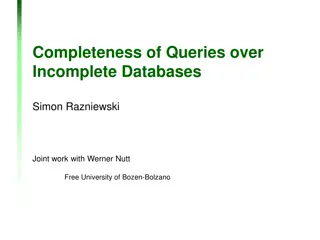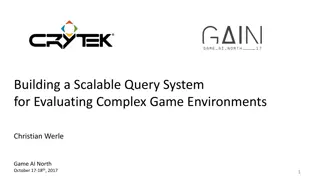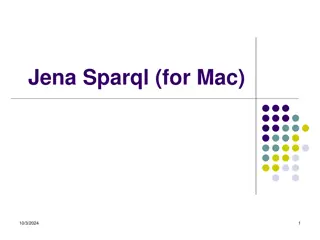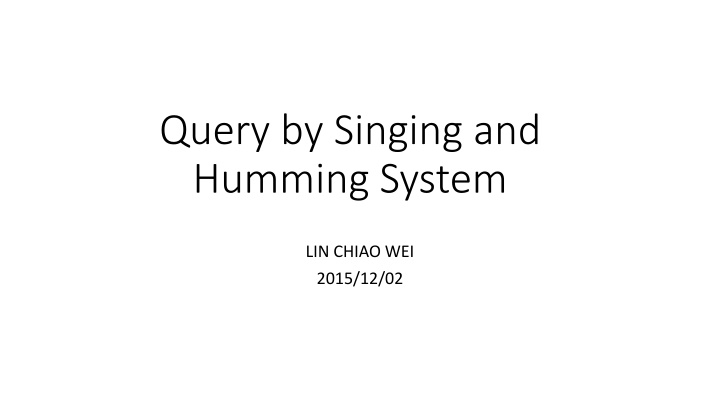
Innovative Query by Singing and Humming System
"Discover how the Query by Singing and Humming System, developed by Lin Chiao Wei in 2015, helps retrieve forgotten songs by analyzing humming input and comparing it with a database. Explore the three main components: Onset Detection, Pitch Estimation, and Melody Matching, utilizing advanced methods like Autocorrelation Function and Hidden Markov Model. Dive into the system diagram and detailed processes such as Magnitude Method and Short-term Energy Method for effective song retrieval."
Download Presentation

Please find below an Image/Link to download the presentation.
The content on the website is provided AS IS for your information and personal use only. It may not be sold, licensed, or shared on other websites without obtaining consent from the author. If you encounter any issues during the download, it is possible that the publisher has removed the file from their server.
You are allowed to download the files provided on this website for personal or commercial use, subject to the condition that they are used lawfully. All files are the property of their respective owners.
The content on the website is provided AS IS for your information and personal use only. It may not be sold, licensed, or shared on other websites without obtaining consent from the author.
E N D
Presentation Transcript
Query by Singing and Humming System LIN CHIAO WEI 2015/12/02
QBSH Retrieve a song when forgetting the names of singer and song. Extracting information from the humming input, comparing with database, and ranking by similarity. Include three main part: Onset detection Pitch estimation Melody matching
Onset detection - Magnitude Method - Short-term Energy Method - Surf Method - Envelope Match Filter Pitch estimation - Autocorrelation Function - Average Magnitude Difference Function - Harmonic Product Spectrum - Proposed Method Melody matching - Hidden Markov Model - Dynamic Programming - Linear Scaling
Onset detection - Magnitude Method - Short-term Energy Method - Surf Method - Envelope Match Filter Pitch estimation - Autocorrelation Function - Average Magnitude Difference Function - Harmonic Product Spectrum - Proposed Method Melody matching - Hidden Markov Model - Dynamic Programming - Linear Scaling
Onset Onset refers to the beginning of a sound or music note. Capture the sudden changes of volume in music signal. [1] J. P. Bello, L. Daudet, S. Abdallah et al., A tutorial on onset detection in music signals, Speech and Audio Processing, IEEE Transactions on, vol. 13, no. 5, pp. 1035-1047, 2005.
Magnitude Method Use volume as feature. Steps: (1) Find envelope amplitude: ??= max ???{? ? } ??0 ? (? + 1)?0 (2) Magnitude difference: ??= ?? ?? 1 (3) If ??> threshold, ??0is recognized as the location of onset. Disadvantage: highly effected by the background noise and the chosen threshold value
Short-term Energy Method Use energy as feature. Disadvantage: sensitive to noise and the chosen threshold value Two ways to implement.
Short-term Energy Method (1) Type 1: similar to magnitude method. Steps: ?+1 ?0 1?2[?] (1)??= ?=??0 (2) ??= ?? ?? 1 (3) If ??> threshold, ??0is recognized as the location of onset.
Short-term Energy Method (2) Type 2: transfer to binary sequence. Steps: ?+1 ?0 1?2[?] (1) ??= ?=??0 (2)??= 1, if ??> threshold 0, if ?? threshold (3) For each continuous 1-sequences, set the first one as onset and the last one as offset. 0 0 1 1 1 0 0 1 1 1 1 0 onset offset onset offset
Surf Method Use the slope of envelope to detect onsets. Disadvantage: require more computation time. [2] S. Pauws, "CubyHum: a fully operational" query by humming" system. , ISMIR, pp. 187-196, 2002
Surf Method Steps: (1) Find envelope amplitude: ??= max ???{? ? } ??0 ? (? + 1)?0 (2) Approximate Amfor m=k-2 ~ k+2 by a second-order polynomial function p m = ??+ ??? ? + ??(? ?)2. The coefficients ??is the slope of the center (m=0) for which ??= ?= 2 ??+??/ ?= 2 2 2 ?2. (3) If bk> threshold, ??0is recognized as the location of onset.
Envelope Match Filter Steps: (1) Find envelope amplitude: ??= max ? ? ??0 ? (? + 1)?0 (2) Normalization ?? 0.2 + 0.1 ??)0.7 ??= ( (3) ??= ???????????(??,?), where f is the match filter. (4) If ??> threshold, then ??0is recognized as the location of onset.
Onset detection - Magnitude Method - Short-term Energy Method - Surf Method - Envelope Match Filter Pitch estimation - Autocorrelation Function - Average Magnitude Difference Function - Harmonic Product Spectrum - Proposed Method Melody matching - Hidden Markov Model - Dynamic Programming - Linear Scaling
Pitch extraction Estimate the fundamental frequency of each note. Sound produced by humming are along with harmonics which interrupt the estimation of fundamental frequency.
Autocorrelation Function ? 1 ? 1 ACF(?) = ? ? ?(?)?(? + ?) ?=0 Where N is the length of signal x, n is the time lag value. If ACF has highest value at n=K K time period of signal fundamental frequency 1/K. [4] J.-S. R. Jang, Audio signal processing and recognition, Information on http://www. cs. nthu. edu. tw/~ jang, 2011.
Average Magnitude Difference Function ? 1 ? 1 AMDF n = ? ? ? ? ?(? + ?) ?=0 If AMDF has a low value approximate to 0 at n=K K time period of signal fundamental frequency 1/K. [4] J.-S. R. Jang, Audio signal processing and recognition, Information on http://www. cs. nthu. edu. tw/~ jang, 2011.
Harmonic Product Spectrum pitch extraction method in the frequency domain [4] J.-S. R. Jang, Audio signal processing and recognition, Information on http://www. cs. nthu. edu. tw/~ jang, 2011.
Proposed method Frequency domain method Get top 3 peaks at f1, f2, f3. Fundamental frequency=min(f1, f2, f3).
Onset detection - Magnitude Method - Short-term Energy Method - Surf Method - Envelope Match Filter Pitch estimation - Autocorrelation Function - Average Magnitude Difference Function - Harmonic Product Spectrum - Proposed Method Melody matching - Hidden Markov Model - Dynamic Programming - Linear Scaling
Melody Matching Transfer the pitch sequence extracted into MIDI number. Compare the numeral sequence of sung input with those in database.
Dynamic Programming A method to find an optimum solution to a multi-stage decision problem. Use in DNA sequence matching. Alignment matrix constructed by query sequence Q and target sequence T ?????????? ? 1,? 1 + ???? ?????(??,?? ?????????? ? 1,? 1 ?????????? ?,? 1 1 ?????????? ?,? = max ???? ????? ??,?? = 2, ?? ??= ?? ?? ?????? 2,
Dynamic Programming ?????????? ? 1,? 1 + ???? ?????(??,?? ?????????? ? 1,? 1 ?????????? ?,? 1 1 ?????????? ?,? = max ???? ????? ??,?? = 2, ?? ??= ?? ?? ?????? 2, Target G A B B Query 0 -1 -2 -3 -4 G -1 2 1 0 -1 D -2 1 0 -1 -2 1 + ???? ?????(??,?? 0 1 0 1 = 3 = 1 = 1 A ?????????? ?,? = max -3 0 3 2 -1 C -4 -1 2 1 0 B -5 -2 1 4 3
Dynamic Programming Target G A B B Query 0 -1 -2 -3 -4 G -1 2 1 0 -1 D -2 1 0 -1 -2 A -3 0 3 2 -1 C -4 -1 2 1 0 B -5 -2 1 4 3 route Target Query 1 2 3 4 G - AB - B GDA - CB G - A - BB GDAC - B G - ABB GDACB G - A - B B G D A C B -
Markov Model Markov model: a probability transition model Three basic elements: (1)A set of states ? = {?1,?2, ,??} (2)A set of transition probabilities T (3)A initial probability distribution from to 1 0.5 0.5 1 1
Hidden Markov Model Hidden Markov model: an extended version of Markov Model. Each state is a probability function. RGBGGBBGRRR [8] Fundamentals of Speech Signal Processing, http://speech.ee.ntu.edu.tw/DSP2015Autumn/
Hidden Markov Model for melody matching No zero-probability transition exists. Give the observations not occur a minimal probability ?? From From To To 0.0425 0.0434 0.0425 0.0425 0.2 0.05 0.05 0.05 0.05 0.05 0.8333 0.4348 0.0425 0.0425 0.2 1 0.5 0.05 0.05 0.05 0.0425 0.4348 0.0425 0.0425 0.2 0.05 0.5 0.05 0.05 0.05 0.0425 0.0434 0.8333 0.8333 0.2 0.05 0.05 1 1 0.05 0.0425 0.0434 0.0425 0.0425 0.2 0.05 0.05 0.05 0.05 0.05
Linear Scaling A straightforward frame-based method. 3 factors: scaling factor, scaling-factor bounds and resolution. [4] J.-S. R. Jang, Audio signal processing and recognition, Information on http://www. cs. nthu. edu. tw/~ jang, 2011.
Conclusion Query-By-Singing and Humming system makes people search their desired songs by content-based method. Some onset detection methods: magnitude method, surf method, and envelope match filter. Pitch detection method: autocorrelation function, average magnitude difference function, harmonic product spectrum and our proposed method. Melody matching: dynamic programming, hidden-Markov model and linear scaling.
Reference [1] J. P. Bello, L. Daudet, S. Abdallah et al., A tutorial on onset detection in music signals, Speech and Audio Processing, IEEE Transactions on, vol. 13, no. 5, pp. 1035-1047, 2005. [2]S. Pauws, "CubyHum: a fully operational" query by humming" system. , ISMIR, pp. 187-196, 2002 [3] J.-J. Ding, C.-J. Tseng, C.-M. Hu et al., "Improved onset detection algorithm based on fractional power envelope match filter." pp. 709-713. [4] J.-S. R. Jang, Audio signal processing and recognition, Information on http://www. cs. nthu. edu. tw/~ jang, 2011. [5] X.-D. Mei, J. Pan, and S.-h. Sun, "Efficient algorithms for speech pitch estimation." pp. 421-424.
Reference [6] M. J. Ross, H. L. Shaffer, A. Cohen et al., Average magnitude difference function pitch extractor, Acoustics, Speech and Signal Processing, IEEE Transactions on, vol. 22, no. 5, pp. 353-362, 1974. [7] M. R. Schroeder, Period Histogram and Product Spectrum: New Methods for Fundamental Frequency Measurement, The Journal of the Acoustical Society of America, vol. 43, no. 4, pp. 829-834, 1968. [8] Fundamentals of Speech Signal Processing, http://speech.ee.ntu.edu.tw/DSP2015Autumn/ [9] R. Bellman, Dynamic programming and Lagrange multipliers, Proceedings of the National Academy of Sciences of the United States of America, vol. 42, no. 10, pp. 767, 1956. [10] L. R. Rabiner, A tutorial on hidden Markov models and selected applications in speech recognition, Proceedings of the IEEE, vol. 77, no. 2, pp. 257-286, 1989.



